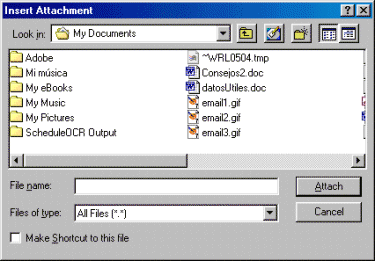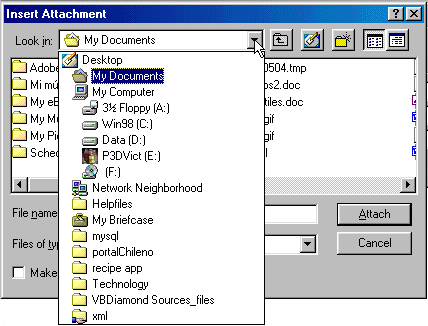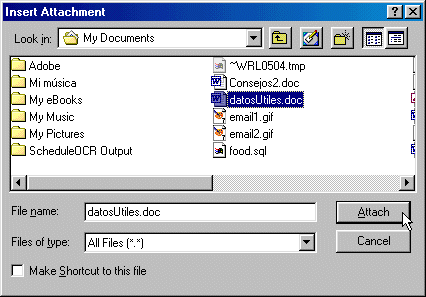Problems
A loyal listener of the program Portal Chileno called us with the following question:
Guys, you are so cool. How do I do an email attachment?
Dear O.R de A.: In order to answer your question, we have described the steps to take below.
Sending an attachment by email
You have that perfect picture to send to a friend, or a document that you have to send to a person, and you want to send it by email. How can this be done? The answer is: by using email attachments.
The following steps demonstrate how to successfully send an email attachment using Outlook Express 6. These steps are not much different for those of you using Outlook Express 5 or lower, or Outlook 2000 or lower. Most other email programs also allow you to attach a file to your email, however the steps may be different than those described below.
 1. First, open Outlook Express. Click on the button "Create Mail", shown in Figure 1, to compose a new email message. The "New Message" window will appear.
1. First, open Outlook Express. Click on the button "Create Mail", shown in Figure 1, to compose a new email message. The "New Message" window will appear.
Figure 1
2. Enter the email address of the person you are sending the email to, the subject, and type the message, just like you would for any email you send. Now you are ready to do the attachment. Click on the "Attach" button on the toolbar (circled in Figure 2).
Figure 2

3. After clicking on the "Attach" buttom, a dialog box will pop up that allows you
to select the file you want to attach. (See Figure 3)
Figure 3

The default directory is "My Documents". If the file you want to
send is located in another place on your computer, go to that place. For
example, if the file you wanted was located in the folder "portalChileno", then
you would click on the down arrow beside the text "My Documents" (see Figure 4),
and then click on the folder labeled "portalChileno" from the list that drops down.
The file names then appear in the larger space.
Figure 4

4. Find the file that you want to send, and click on it to select it. The
name of the file you selected will appear in the space beside the text
"File Name:" (see Figure 5). In this example, the file selected is called
"datosUtiles.doc." In order for the attachment to work the file name must
appear in this space. Then click on the Attach button.
Figure 5

5. After you click on the Attach button, your email message will show again, and now
you will see a new line called "Attach:" and the file name you selected is
displayed (see Figure 6). This file is now attached to the email.
Figure 6

The number after the file name, 29.5 KB in this example, indicates the size of the
file. Most documents are not very big. However, if you are sending a picture
or movie, you must be careful because these files are generally very large.
Some email services do not allow attachments that are larger than a certain size.
For example, Hotmail users can not send an attachment larger than 1 MB.
Note: 1MB = 1024 KB
6. To send you email, simply click the Send button. Your email will be sent along
with the attachment. If the attachment is large, it may take a few minutes for the
email to be sent, depending on your connection speed (a cable modem will send it
much faster than a 56K telephone modem). Just be patient.
Sending multiple attachments
You can send more than one attachment with a single email. Simply repeat the steps
above for each file you want to attach. All attachments will display in the
Attach field, as shown by the circled area in Figure 7.
Figure 7

Remember that often there is a limit on the size of attachments allowed. In the
case of multiple attachments, the sum of all file sizes gives the total size.
In the example below, the total size is 329.5 KB. That size should be well within
the range of most email services. If you look below at Figure 8, you will see
that the total attachment size is well over 5 MB. You probably will not be able
to send this email.
Removing an Attachment
If you make a mistake and accidentally attach the wrong file, or realize that the
file you attached is too large (as in Figure 8 below), do not fear. It is possible
to remove an attached file.
Figure 8

Click on the file name that you want to remove. It will become highlighted. Then
press the Delete key on your keyboard (it is labeled Del). The highlighted file
will be removed from the list.
Opening Attachments
Always have caution when you receive an attachment, even if it is from someone that you know.
The most common way for a virus to spread is through an infected attachment. To keep
your computer virus-free, always take the following precautions:
- Make sure you have antivirus software installed and your virus definitions
are up-to-date. One of the best antivirus software packages available is
Norton Antivirus.
- Always save and scan the attachment first.
- To save the attachment to your hard drive, right click on the attachment name
(it usually appears as a line labeled "Attach" below the Subject line) and select
Save As... from the pop-up menu. Save the attachment in a place where
you can easily find it again, such as your Desktop or My Documents folder.
- Now go to the saved file so you can scan it with your antivirus software.
Right click on the file, and select the scanning option. In our example, Norton
Antivirus is installed, so we select the option Scan with Norton Antivirus.
- Only when the scan is complete and your antivirus software does not detect any
virus should you open the attachment.